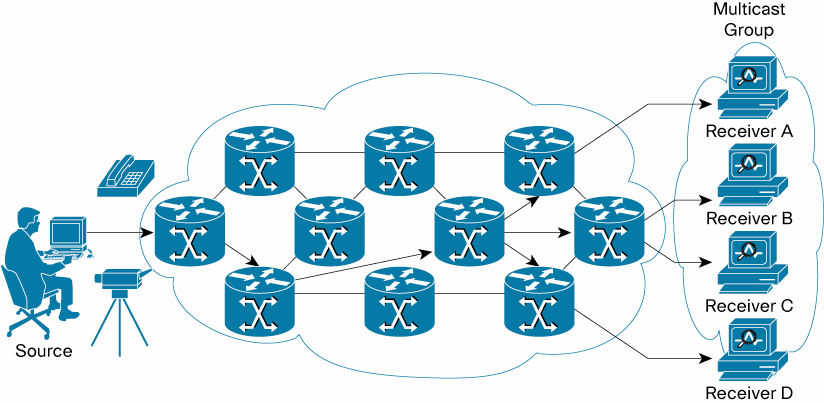Multicast was supported on Internet Protocol version 4 (IPv4) networks, but was never widely deployed because of architectural, management and security limitations. Multicast support on IPv6 networks overcame these limitations and is more widely deployed. This article provides information about deploying and configuring IPv6 multicast on internets.
This article is organized into 4 parts:
- Review basic multicast terminology, addressing, and configuration
- Infrastructure applications enabled by IPv6 multicast
- Reference documents for multicast node configuration
- Multicast troubleshooting
1. Review
This article explains basic multicasting concepts and terminology and compares multicast with broadcast and anycast. This article describes the multicast address structure. This presentation further explains multicast terminology, describes multicast addressing and discusses issues to consider when configuring multicast source (root) nodes, receiver (leaf) nodes, and intermediate nodes (routers) populating a multicast distribution tree (MDT). Internet Engineering Task Force (IETF) Request for Comments (RFC) 6308 provides an overview of the Multicast Addressing Architecture and RFC 7371 provides an update to RFC 6308.

Example of a Multicast Distribution Tree
An MDT is an arbitrary group of receivers that have expressed an interest in receiving a data stream from a particular source. This presentation describes the various types of multicast groups, multicast address formats, and the dynamics of joining, leaving, reporting, and querying an MDT. This article describes a deployment of IPv6 multicast in conjunction with MultiProtocol Label Switching (MPLS) Virtual Private Networks (VPNs). This presentation describes a deployment of IPv6 multicast in conjunction with Internet Protocol Security (IPsec). This article discusses the use of IPv6 multicast with Internet Control Message Protocol for IPv6 (ICMPv6) for secure autoconfiguration. This series of articles discuss the use of IPv6 multicast with ICMPv6 for neighbor discovery (the articles are listed in reverse order). In the Security section of the IPv6 Knowledge Base, this article discusses neighbor discovery attacks and this article includes a discussion of neighbor discovery attack mitigations.
For additional details about and limitations when using IPv6 multicast with IPsec, see paragraph 5.3.3 of the National Institute of Standards and Technology Special Publication 800-119, Guidelines for the Secure Deployment of IPv6.
2. Infrastructure applications
Since its earliest deployment on IPv6 networks, multicast has been recognized as an effective technique for video conferencing and content distribution (including by commercial radio and television networks). This presentation shows how IPv6 multicast can simplify the configuration and management of infrastructure applications such as Dynamic Host Configuration Protocol (DHCP), X Display Manager Control Protocol (XDMCP), Network Time Protocol (NTP), as well as less obvious infrastructure applications like Domain Name Service (DNS) protocol [not to be confused with Apple’s Bonjour a.k.a. multicast Domain Name System (mDNS)]. IPv6 multicast can even be used to install an operating system image across multiple computers in parallel, as described in this article. Additional infrastructure applications enabled by IPv6 multicast are mentioned in the Deployment section of this Wikipedia IP Multicast article.
3. Reference documents
The configuration of computer operating systems as receivers to discover or join an MDT were described in the articles and presentations referenced in part 1 above. The details of configuring various router operating systems as intermediate nodes on an MDT appear below:
- Nokia OS
- Extreme Networks NetIron IPv6 Multicast Configuration
- Cisco IOS
- Juniper JUNOS
Selected additional references appear below:
- Internet Assigned Numbers Authority (IANA) IPv6 Multicast Address Space Registry
- Microsoft Windows sockets
- Oracle Solaris (in the IPv6 Multicast Addresses in Depth section)
- java
4. Multicast troubleshooting
Basic troubleshooting tools and techniques are described in this presentation and in paragraphs 6.14 and 6.15 of Nippon Telegraph and Telephone (NTT) Information Sharing Platform Laboratories Deploying IPv6: Problems and Solutions. More advanced troubleshooting techniques with an emphasis on Protocol Independent Multicast Sparse Mode (PIM-SM) routing are described in this article. This article describes troubleshooting techniques for several multicast routing modes.
